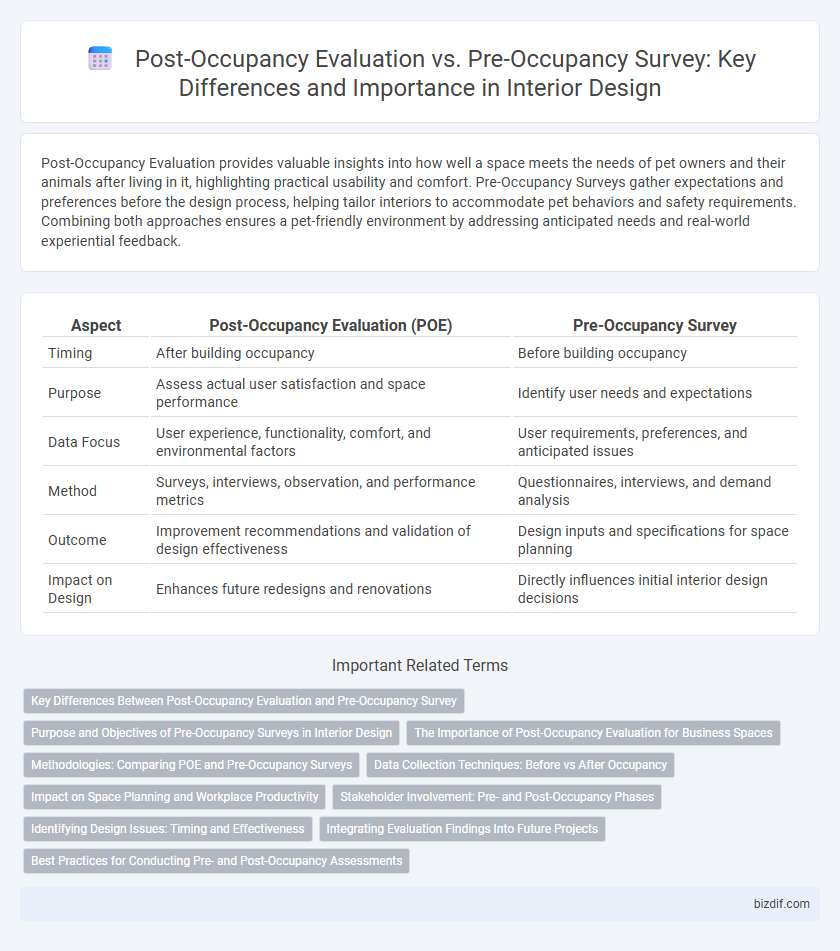Post-Occupancy Evaluation provides valuable insights into how well a space meets the needs of pet owners and their animals after living in it, highlighting practical usability and comfort. Pre-Occupancy Surveys gather expectations and preferences before the design process, helping tailor interiors to accommodate pet behaviors and safety requirements. Combining both approaches ensures a pet-friendly environment by addressing anticipated needs and real-world experiential feedback.
Table of Comparison
| Aspect | Post-Occupancy Evaluation (POE) | Pre-Occupancy Survey |
|---|---|---|
| Timing | After building occupancy | Before building occupancy |
| Purpose | Assess actual user satisfaction and space performance | Identify user needs and expectations |
| Data Focus | User experience, functionality, comfort, and environmental factors | User requirements, preferences, and anticipated issues |
| Method | Surveys, interviews, observation, and performance metrics | Questionnaires, interviews, and demand analysis |
| Outcome | Improvement recommendations and validation of design effectiveness | Design inputs and specifications for space planning |
| Impact on Design | Enhances future redesigns and renovations | Directly influences initial interior design decisions |
Key Differences Between Post-Occupancy Evaluation and Pre-Occupancy Survey
Post-Occupancy Evaluation (POE) focuses on assessing the actual performance and user satisfaction of an interior space after occupation, providing data on functionality, comfort, and environmental quality. In contrast, Pre-Occupancy Survey (POS) centers on anticipating user needs and design effectiveness before use, aiming to identify potential issues and preferences. The key difference lies in POE's retrospective analysis of real-world outcomes versus POS's predictive assessment of design plans and expectations.
Purpose and Objectives of Pre-Occupancy Surveys in Interior Design
Pre-Occupancy Surveys in interior design aim to assess spatial functionality, lighting, acoustics, and ergonomic features before finalizing design implementations, ensuring alignment with client needs and building regulations. These surveys establish baseline conditions, identify potential design conflicts, and enable early adjustments to optimize occupant comfort and productivity. Their primary objective is to minimize costly revisions and enhance the overall user experience by refining design strategies prior to occupancy.
The Importance of Post-Occupancy Evaluation for Business Spaces
Post-Occupancy Evaluation (POE) provides critical insights into how business spaces perform in real-world conditions, measuring occupant satisfaction, space utilization, and environmental quality. Unlike Pre-Occupancy Surveys that predict needs before use, POE identifies actual operational issues and informs targeted improvements to enhance productivity and employee well-being. Implementing POE drives data-informed decisions that optimize workplace design effectiveness, reduce costs, and increase long-term business value.
Methodologies: Comparing POE and Pre-Occupancy Surveys
Post-Occupancy Evaluation (POE) utilizes systematic data collection methods such as occupant interviews, space utilization analysis, and environmental quality measurements to assess the effectiveness of interior design after project completion. In contrast, Pre-Occupancy Surveys primarily involve client questionnaires, spatial needs assessments, and ergonomic evaluations conducted before space completion to inform design decisions. Comparing methodologies, POE emphasizes empirical performance data and user feedback post-occupancy, while Pre-Occupancy Surveys focus on predictive assessments and user requirements during the design phase.
Data Collection Techniques: Before vs After Occupancy
Post-Occupancy Evaluation (POE) utilizes methods such as occupant surveys, spatial utilization tracking, and environmental sensors to collect data on actual user interaction and comfort within the designed space after occupancy. In contrast, Pre-Occupancy Surveys rely primarily on interviews, focus groups, and design intent questionnaires to gather anticipated user needs and expectations before the space is inhabited. These data collection techniques provide critical insights that influence ongoing design improvements and validate design decisions based on real-world usage versus predicted outcomes.
Impact on Space Planning and Workplace Productivity
Post-Occupancy Evaluation (POE) provides critical insights into actual user experience and space utilization, allowing designers to optimize layouts based on real-world feedback, which directly enhances workplace productivity. Pre-Occupancy Surveys gather occupant expectations and preferences before move-in, influencing initial space planning decisions but lacking empirical validation of how environments perform under daily operational conditions. Integrating both methods ensures a comprehensive approach to designing workspaces that balance anticipated needs with measurable outcomes, ultimately maximizing functionality and employee satisfaction.
Stakeholder Involvement: Pre- and Post-Occupancy Phases
Stakeholder involvement in interior design varies significantly between pre- and post-occupancy phases, with pre-occupancy surveys focusing on gathering user needs, preferences, and functional requirements to inform space planning and material selection. Post-occupancy evaluations emphasize collecting feedback on actual user experience, comfort, and functionality, enabling designers to assess the effectiveness of design interventions and identify areas for improvement. Engaging occupants early through pre-occupancy surveys and maintaining communication through post-occupancy evaluations ensures that interior environments are both user-centered and performance-optimized.
Identifying Design Issues: Timing and Effectiveness
Post-Occupancy Evaluation (POE) identifies design issues by assessing how occupants interact with the space after extended use, revealing functionality and comfort problems that were not apparent during planning. Pre-Occupancy Surveys provide early feedback on expectations and immediate impressions but often miss latent usability flaws that only emerge over time. Timing is critical as POE delivers more effective insights into long-term design performance, enabling targeted improvements based on real occupant experience.
Integrating Evaluation Findings Into Future Projects
Post-Occupancy Evaluation (POE) provides valuable insights into how occupants interact with and experience a space, allowing designers to identify practical improvements and unforeseen issues. Pre-Occupancy Surveys focus on user expectations and requirements before implementation, setting a foundation for project goals but lacking real-world feedback. Integrating findings from both methods ensures future interior design projects are evidence-based, user-centric, and optimized for functionality and comfort.
Best Practices for Conducting Pre- and Post-Occupancy Assessments
Conducting Pre-Occupancy Surveys involves gathering user expectations, space functionality requirements, and environmental preferences to inform design decisions effectively. Post-Occupancy Evaluation focuses on assessing actual occupant satisfaction, spatial performance, and environmental quality to identify necessary improvements and validate design outcomes. Best practices include employing structured questionnaires, direct observations, and occupant interviews at both stages to ensure comprehensive, data-driven feedback that enhances overall interior design success.
Post-Occupancy Evaluation vs Pre-Occupancy Survey Infographic

 bizdif.com
bizdif.com